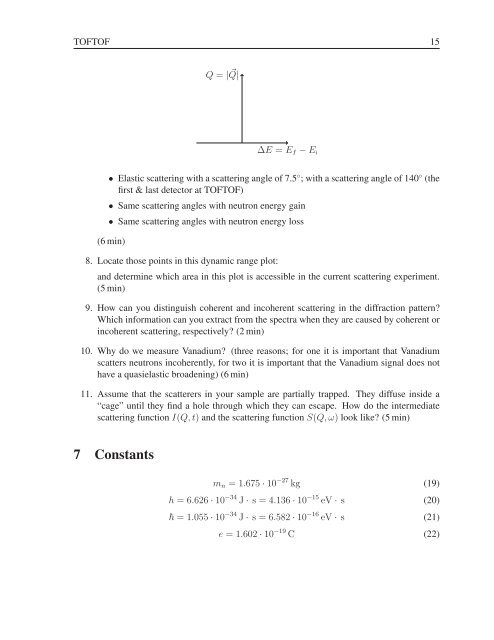- Page 1 and 2:
Member of the Helmholtz Association
- Page 4 and 5:
Forschungszentrum Jülich GmbH Jül
- Page 6:
��������� 1 PUMA
- Page 9 and 10:
2 O. Sobolev, A. Teichert, N. Jünk
- Page 11 and 12:
4 O. Sobolev, A. Teichert, N. Jünk
- Page 13 and 14:
6 O. Sobolev, A. Teichert, N. Jünk
- Page 15 and 16:
8 O. Sobolev, A. Teichert, N. Jünk
- Page 17 and 18:
10 O. Sobolev, A. Teichert, N. Jün
- Page 19 and 20:
12 O. Sobolev, A. Teichert, N. Jün
- Page 21 and 22:
14 O. Sobolev, A. Teichert, N. Jün
- Page 23 and 24:
2 POWDER DIFFRACTOMETER SPODI Conte
- Page 25 and 26:
4 POWDER DIFFRACTOMETER SPODI 2. Ba
- Page 27 and 28:
6 POWDER DIFFRACTOMETER SPODI Ewald
- Page 29 and 30:
8 POWDER DIFFRACTOMETER SPODI Powde
- Page 31 and 32:
10 POWDER DIFFRACTOMETER SPODI Rela
- Page 33 and 34:
12 POWDER DIFFRACTOMETER SPODI Prof
- Page 35 and 36:
14 POWDER DIFFRACTOMETER SPODI neut
- Page 37 and 38:
16 POWDER DIFFRACTOMETER SPODI The
- Page 39 and 40:
18 POWDER DIFFRACTOMETER SPODI 4 U
- Page 41 and 42:
20 POWDER DIFFRACTOMETER SPODI 7. E
- Page 43 and 44:
22 POWDER DIFFRACTOMETER SPODI Figu
- Page 45 and 46:
24 POWDER DIFFRACTOMETER SPODI Cont
- Page 47 and 48:
2 M. Meven Contents 1 Introduction
- Page 49 and 50:
4 M. Meven a (hkl) Plane. Each plan
- Page 51 and 52:
6 M. Meven wavelengths � in the s
- Page 53 and 54:
8 M. Meven intensities (I~Z 2 ) tha
- Page 55 and 56:
10 M. Meven This has to be taken in
- Page 57 and 58:
12 M. Meven 4 Sample Section 4.1 In
- Page 59 and 60:
14 M. Meven Fig. 8 (a) orthorhombic
- Page 61 and 62:
16 M. Meven 4.3 Oxygen Position The
- Page 63 and 64:
18 M. Meven To direct the secondary
- Page 65 and 66:
20 M. Meven For a given spectrum
- Page 67 and 68:
22 M. Meven References [1] Th. Hahn
- Page 69 and 70:
24 M. Meven
- Page 71 and 72:
26 M. Meven
- Page 73 and 74:
28 M. Meven
- Page 75 and 76:
30 M. Meven
- Page 78 and 79:
SPHERES Backscattering spectrometer
- Page 80 and 81:
SPHERES 3 1 Introduction Neutron ba
- Page 82 and 83:
SPHERES 5 Fig. 2: The monochromator
- Page 84 and 85:
SPHERES 7 While the primary spectro
- Page 86 and 87:
SPHERES 9 neutron is scattered, it
- Page 88 and 89:
SPHERES 11 The stationary equilibri
- Page 90 and 91:
SPHERES 13 4. Summarize the tempera
- Page 92 and 93:
________________________ DNS Neutro
- Page 94 and 95:
DNS 3 1 Introduction Polarized neut
- Page 96 and 97:
DNS 5 Monochromator horizontal- and
- Page 98 and 99:
DNS 7 3 Preparatory Exercises The p
- Page 100 and 101:
DNS 9 important and always necessar
- Page 102:
DNS 11 Contact ���� Phone:
- Page 105 and 106:
2 O. Holderer, M. Zamponi and M. Mo
- Page 107 and 108:
4 O. Holderer, M. Zamponi and M. Mo
- Page 109 and 110:
6 O. Holderer, M. Zamponi and M. Mo
- Page 111 and 112:
8 O. Holderer, M. Zamponi and M. Mo
- Page 113 and 114:
10 O. Holderer, M. Zamponi and M. M
- Page 115 and 116:
12 O. Holderer, M. Zamponi and M. M
- Page 117 and 118:
14 O. Holderer, M. Zamponi and M. M
- Page 119 and 120:
2 H. Frielinghaus, M.-S. Appavou Co
- Page 121 and 122:
4 H. Frielinghaus, M.-S. Appavou Th
- Page 123 and 124: 6 H. Frielinghaus, M.-S. Appavou Fi
- Page 125 and 126: 8 H. Frielinghaus, M.-S. Appavou mo
- Page 128 and 129: ________________________ KWS-3 Very
- Page 130 and 131: KWS-3 3 1 Introduction Ultra small
- Page 132 and 133: KWS-3 5 2. The standard Q-range of
- Page 134 and 135: KWS-3 7 Table 2. Samples for practi
- Page 136 and 137: KWS-3 9 References [1] Eskilden, M.
- Page 138 and 139: ________________________ RESEDA Res
- Page 140 and 141: RESEDA 3 1 Introduction Neutrons ar
- Page 142 and 143: RESEDA 5 various length values l ac
- Page 144 and 145: RESEDA 7 In this expression, a norm
- Page 146 and 147: RESEDA 9 spin flip from up to down
- Page 148 and 149: RESEDA 11 The neutrons are counted
- Page 150: RESEDA 13 Contact �����
- Page 153 and 154: 2 S. Mattauch and U. Rücker Conten
- Page 155 and 156: 4 S. Mattauch and U. Rücker Fig. 2
- Page 157 and 158: 6 S. Mattauch and U. Rücker 4 Expe
- Page 159 and 160: 8 S. Mattauch and U. Rücker Contac
- Page 161 and 162: 2 H. Morhenn, S. Busch, G. Simeoni
- Page 163 and 164: 4 H. Morhenn, S. Busch, G. Simeoni
- Page 165 and 166: 6 H. Morhenn, S. Busch, G. Simeoni
- Page 167 and 168: 8 H. Morhenn, S. Busch, G. Simeoni
- Page 169 and 170: 10 H. Morhenn, S. Busch, G. Simeoni
- Page 171 and 172: 12 H. Morhenn, S. Busch, G. Simeoni
- Page 173: 14 H. Morhenn, S. Busch, G. Simeoni
- Page 178 and 179: Schriften des Forschungszentrums J
- Page 180 and 181: Schriften des Forschungszentrums J
- Page 182 and 183: Schriften des Forschungszentrums J

















